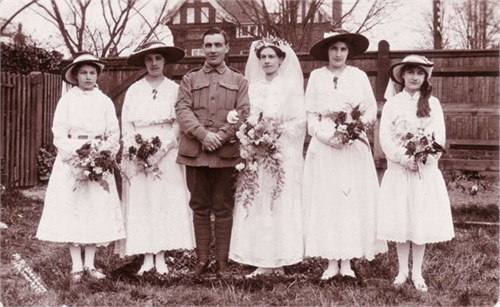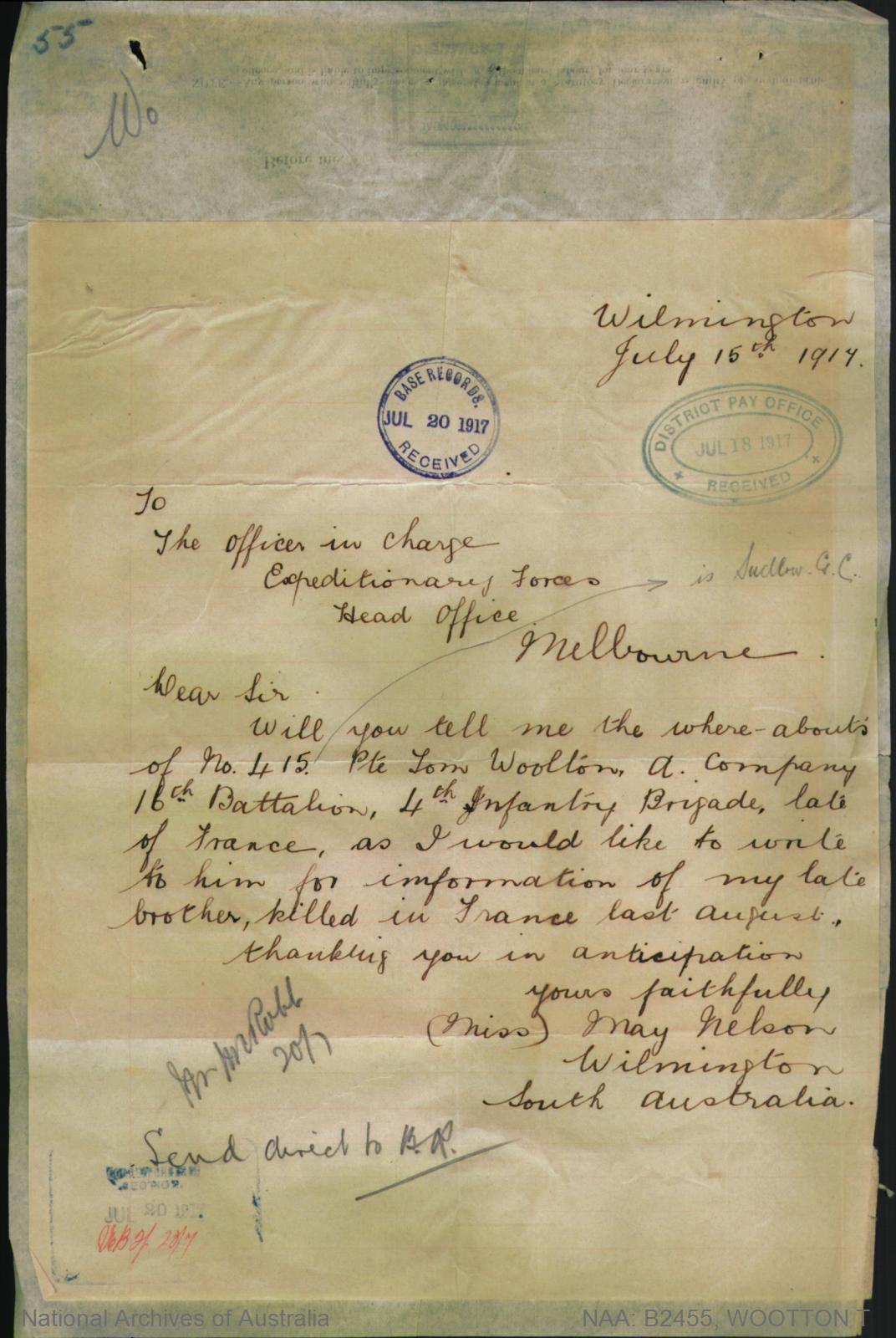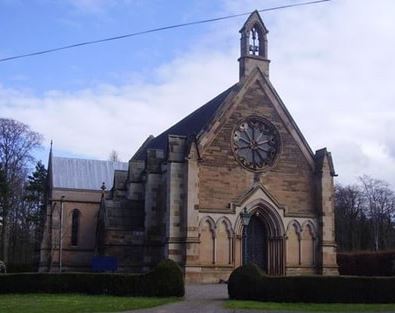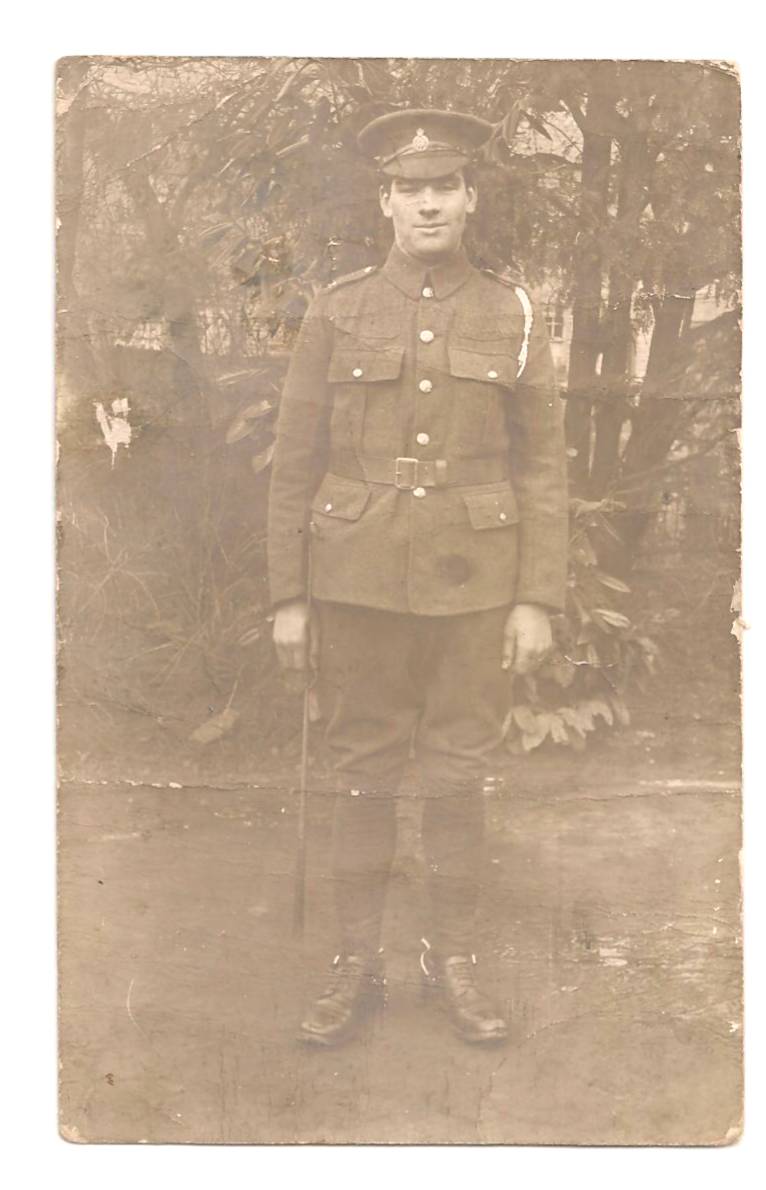At the start of the Great War the population of Byford in Herefordshire, including children, was 148 and Mansell Gamage 116, giving a total of 264 inhabitants.
51 young men enlisted from the two villages and 13 of those sadly died. The others returned, but life would never be the same for them after their experiences.
Of those 51 men who enlisted, 6 of them were connected to my Wootton Family, 4 of them came home, but sadly two of them gave the ultimate sacrifice for their Country.
All 6 were related, 4 Sons Born to James Wootton and Robina Wootton and 2 Sons born to John Henry Wootton and Frances Wootton and they were all ‘Cousins’.
In the first of 2 blogs, let me share with you their stories…………
Sergeant Thomas Wootton
Service Number 416 16th Battalion Australian Infantry
Killed in action 26 September 1917 aged 26
Commemorated on the Menin Gate, Ypres, Belgium (Panel 17) and the Australian National War Memorial (Panel 81)

(Thomas Wootton Australian Infantry – Photograph from Anne Teesdale)
Thomas Wootton was the son of John and Frances Wootton who farmed at Lower House, Byford and the older Brother of William Wootton, of the Seaforth Highlanders. At the time of his death, he had a wife Mary Louisa Wootton, (nee Staples) from Dalkeith in Scotland. He was baptised in Byford church on May 8th1892 and attended Byford school from 1898 to 1906, winning the attendance prize in 1904. In 1913 he decided to emigrate to Australia and on 14th August sailed on SS Demosthenes from London to Fremantle.

His attempt to start a new life in Australia was disrupted by the war and he immediately enlisted in Helenvale where he was living, a town just east of Perth and the site of Blackboy Camp where the 16thBattalion was forming. Together with the 13th, 14th and 15th Battalions, they made up the 4th Brigade commanded by Colonel John Monash.
At the time of his enlistment, on 16th October 1914, Thomas was occupied as a Dairyman. His physical details are recorded as follows; Age 22 years 6 months, height 5ft 8 1/2″, weight 164 lbs, chest measurements 35/38″, complexion fair, hair brown, eyes grey. His denomination is listed as C of E and he is listed as having a scar on the inner side of his calf and a vaccination scar on his left arm.
The Brigade left Australia for Egypt on Boxing Day, landed at Anzac Cove, on 25 April 1915 and remained in action at Gallipoli suffering many casualties, until the final evacuation in December, after which Thomas was hospitalised suffering from jaundice. In June 1916 the battalion sailed for France and took part in the bloody trench warfare of the Somme. In December of that year, Thomas was in hospital again, suffering from a severe gunshot wound in the left thigh, which led to him developing gas gangrene. He recovered and rejoined his battalion in August 1917, as it moved to the Ypres Salient and joined the slow and costly advance on the Hindenberg Line.
Thomas Wootton’s movements and injuries can be tracked from his Casualty Form, details as follows:
19.12.15 Sent to Hospital Sick – Gallipoli Peninsula
23.12.15 Onboard Hospital Ship “Tumble Castle” with Jaundice discharged at Alexandria, Egypt.
24.12.15 Admitted to No.1. Aux. Hosp with Jaundice at Luna Park.
11.1.16 Discharged from No.1. Aux. Hosp Discharged to Duty Luna Park.
12.1.16 Overseas base B213 Adm. ex No.1. Aux. Hosp Ghezireh.
10.2.16 Overseas base to Zeitoun to rejoin unit at Ghezireh.
11.3.16 CO 16th Battalion rejoined unit at Tel-el-Kebir.
Proceeded to B.E.F at Alexandria.
Sailed on MT Canada and disembarked at Marseilles.
8.7.16 CO 16th Battalion promoted to Lance Corporal in the field.
9.12.16 Wounded in action. Gunshot wound to left thigh and buttock.
15.12.16 Admitted to 6th Gen. Hosp with gunshot wounds to his left leg at Rouen.
19.12.16 Sailed from Havre on Ship “W. Australia” with gunshot wounds to the left leg to embark in England.
14.4.17 Admitted to 2nd. Aux. Hosp at Southall.
17.4.17 Discharged from 2nd. Aux. Hosp to Weymouth.
22.4.17 Transferred from Southall to No.2.Com Depot Weymouth.
1.7.17 Overseas Training Department Perham Downs.
(Perham Downs was a WW1 Training Camp based in the Salisbury Plains of Wiltshire and further details of the Australian Armies base camps at Weymouth and Southall can be found in the link below.)
Australian Base Camps and Hospitals in the UK
23.7.17 Transferred overseas to France via Southampton.
28.7.17 Joined 4th ADBD at Havre.
11.8.17 Sent to 4th Battalion Havre.
18.8.17 Rejoined 16th Battalion in Field.
25.8.17 Promoted to Sergeant in Field
29.9.17 Reported as Killed in Action 26.9.17
On 26 September 1917, they joined in the attack on Zonnebeke, operating to the north of the main attack on Polygon Wood, in which another local man, Mark Hinksman, was also fighting. Due to a misunderstanding over timing, part of the line ran into its own barrage and the men also suffered badly from sniper fire. Nevertheless, they reached their objectives, but at the cost of more than 100 casualties including Thomas Wootton. His body was never recovered and like his cousin William, he has no known grave.
On 16th May 1915, he had made his will “In the event of my death I give £20 to my sweetheart Miss Louisa Staples, The Laundry, Dalkeith Park, Dalkeith and the remaining part of my property to my loving mother Mrs Wooton of Byford, near Hereford, England.”

(Australian National Archives)

(Wedding of Thomas Wootton and Mary Staples – Photograph from Ann Teesdale)
He Married Married Mary Louisa Staples on 30th April 1917, whilst back here recovering from his Gunshot would to the leg. They Married in Newmarket, Cambridgeshire and I can find no link or connection to this area for either of them. Mary Staples was born in Dalkeith Park, Midlothian, Scotland in 1902. Unproven testimony is that Mary was a Nurse who treated Thomas on his return from the frontline, after being shot and Mary could have been stationed at Newmarket in one of the various Hospitals there. However, the clues are there when we look at the finer details on our Certificates. At the Marriage of Thomas’s younger, Sister Frances Wootton to Arthur Gregson, which took place on 3rd June 1916 in Edinburgh, if you look closely at the witnesses, guess who we find?

(Marriage Record for Arthur Gregson and Frances Mary Wootton)
None other than Mary Louise Staples! So it’s highly likely that Thomas Wootton and Mary Staples had already met at his Sister’s Wedding in 1916.
There are 45 documents that cover Thomas Wootton’s service career, far too many to include them all, but I thought that the documents below were worthy of including.
Medical Case Sheet showing his injury and associated ‘gas gangrene’

(Australian National Archives)
The next document I have included is remarkable given the date, attached below is Thomas Wootton’s full clinical chart, amazing that a document like this has survived.

(Clinical Chart Australian National Archives)
In amongst the papers for Thomas Wootton are two letters, dated July 1917, the first from a Miss May Nelson, from Wilmington, South Australia asking the Officer in charge for the location of Thomas Wootton. She is desperately seeking information on her late Brother who was killed in France, the previous August, one presumes that he was friends with Thomas Wootton. The second letter is a reply from the Brigades Major to Miss Nelson.

(Australian National Archives)

(Australian National Archives)
Thomas Wootton is commemorated alongside many of his fellow Battalion members on the Australian War memorial.

Thomas Wootton is also mentioned in the Roll of Honour for St. Mary’s Episcopal Church in Dalkeith, Scotland the home town of his Wife Mary Wootton (nee Staples)

(St Mary’s Episcopal Church, Dalkeith – Image courtesy of Beth Page, South Australia)

(Roll of Honour, including Thomas Wootton, St Mary’s Episcopal Church, Dalkeith – Image courtesy of Beth Page, South Australia)

(Newspaper announcement of Thomas Wootton’s injury)

(Thomas Wootton’s CWGC entry)
Thomas left this Country with hope, he hoped for a new life in Australia and was willing to travel to seek new adventures and start a new life. Sadly like many of his generation, the ravages of the First World War changed their lives forever and Thomas was one of those who made the ultimate sacrifice.
Our second family member who went to War is Thomas’s younger Brother William Wootton and his story is vastly different to that of his older Brother Thomas, you can read about William’s War below:
William Wootton
Service Number 66 Royal Army Veterinary Corp
Service Number S/43639 5th Battalion Seaforth Highlanders
Service Number 298097 2/4 London Regiment

(William Wootton Army Veterinary Corp – picture from Anne Teesdale)

(William Wootton Seaforth Highlanders – picture from Anne Teesdale)
William Wootton was the younger Brother of Thomas Wootton who went to Australia and the Son of John Henry Wootton and Frances Wootton and was born 29th December 1893 in Byford in Herefordshire.
William first enlisted on 1st April 1915 with Service Number 66 and he served with the 1/1st South Midland Mobile Veterinary Section in France and Italy, before he went to the Western Front in March 1915, until April 1918.
I was fortunate enough to find several mentions of William Wootton in the War Diaries for the 1/1st South Midland Mobile Veterinary Section and despite the horror of War, even the mundane facts of going on leave were recorded.
“April 9th 1915 D.D.V.S. 2Nd Army inspected section. Collected six cases. Dispatched eleven cases to No.10 Veterinary Hospital under Sergt Bray and Trprs. Tarran and Wootton.”

“August 21st 1917 Routine. 24 Cases received 23 cases evacuated DADVS called. TT02181 Pte. Wootton went on leave.”

The unit diary of 16th April 1918 states that TT02164 Cpl E Maund and TT02181 Cpl W Wotton AVC left for No 2 Veterinary Hospital for further training. The No 2 Veterinary Hospital was at (Le) Havre with a detachment in Marseilles. Neither man returned to the unit, both ended up in the infantry.
At the beginning of 1918, the army was short of front line soldiers, and this shortage was exacerbated by the German Spring Offensive. Men serving behind the lines were being combed out for front line duty. The AVC had grown enormously during the war; many of its new men were previously front line troops who were no longer fit for front line service.
The War diaries of the No 2 Veterinary Hospital at both Havre and Marseilles were reporting that AVC men were being medically examined and those deemed fit were reclassified and sent to the front. Corporals Maund and Wotton arrived as this reclassification was happening. What possibly happened was that either they arrived at the No 2 Veterinary Hospital, were given a medical, declared to be A1 fit and promptly despatched to the infantry or, they were re-designated before they even arrived at the hospital. Both went to the London Regiment, with consecutive numbers, and, according to the medal roll, to the 2/4th battalion. Their service numbers correspond to the new numbers allotted the battalion in the 1917 re-numbering. The 2/4th Battalion London Regiment received a draft of 92 other ranks on 13th May 1918 and on 2nd June a draft of 126 other ranks (mostly young men). Corporals Maund and Wootton could have been amongst either of these drafts. The 2/4th battalion was disbanded in September 1918. Both men ended up in the Seaforth Highlanders – numbers no longer adjacent, being S/43637 and S/43639. According to the medal roll, they were in the 5th battalion.

(The National Archives of the UK; Kew, Surrey, England; War Office and Air Ministry: Service Medal and Award Rolls, First World War. WO329; Ref: 1649)
William was one of the lucky ones, he came home to live the remainder of his life, dying in Hereford in 1971. Was it a happy life? We will never know for sure, but sadly for William after he returned home to Rural life, on his father’s farm in Byford, he was involved in an awful tragedy. His loaded gun was accidentally knocked over and tragically killed his 6 year old nephew, Alfred Arthur Gregson.
You can read about this tragic story here:
The Tragic Fatality at Lower House Farm Part 1
The Tragic Fatality at Lower House Farm Part 2
The Tragic Fatality at Lower House Farm Part 3
So not only was William potentially scarred from the horrors of War, he was involved in another fatal killing that split the family forever, so although he survived life would never be the same again for William and the Wootton family.
There is a framed Memorial to all the brave young men of the Villages of Byford and Mansell Gamage who served King and Country during WW1, including the names of those that sadly made the ultimate sacrifice.
“Your Prayers are asked for those who have gone to serve our King and Country by Land and Sea and Air”
William Brookes RIP
George Burborough Percy Burborough
Albert Cartwright Henry Drummond
Albert Davies Edward Hudman
Sydney Davies Thomas Jones
John Hall Arthur Preece
Arthur Haines Charles Kent
James Jellie William Morris
Edward Jones Thomas Wootton
Sydney Jones William Wootton
Benjamin Kent Ernest Jones
Alfred Lawrence George Baker
Henry Lawrence Mark Hinksman
Robert Lawrence George Grubb
William Lawrence
William Lawrence
Charle Liddell
William Mills
Edward Morris
Thomas Morris
James Morgan
William Neath
Charles Preece
John Preece
George Preece
Henry Preece
Sidney Preece
William Preece
Joseph Pewtress
William Saunders
James Saunders
Edward Taylor
Alfred Wootton
George Wootton
Thomas Wootton
Willam Wootton
Younger Young
William Howells
With special thanks to Sue Hubbard, Churchwarden at Byford Church, Herefordshire for all her help with research and her inspiration to write and share these stories.
Please look out for Part 2 and see how the other 4 Wootton Soldiers, faired, would there be more heartbreak and tragedy for “The Wootton Soldiers”, a Family at War.
All My Blogs For Family Tree Magazine in one handy place
Copyright © 2021 Paul Chiddicks | All rights reserved


I have been to Ypres a few times myself and was always overwhelmed by all the people paying tribute to their relatives who died during the great war.
I really love the way you report on this, and you did have a number of great finds indeed!
LikeLiked by 3 people
Thanks Arnold much appreciated, once the lockdown is over I am hoping to visit Gallipoli and Ypres to pay my respects to all those that gave the ultimate sacrifice
LikeLiked by 1 person
Wonderful array of records that you have found. You really get a good idea of what they went through. Thanks for sharing.
LikeLiked by 1 person
Thanks Jude much appreciated
LikeLiked by 1 person